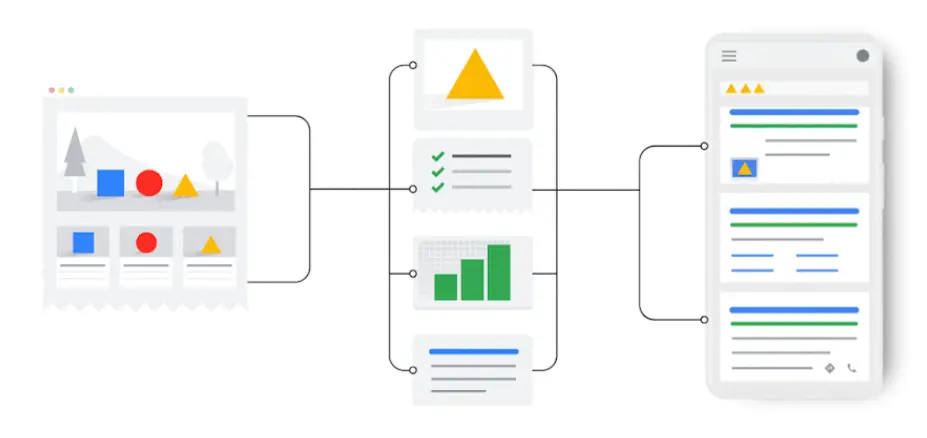If you’ve ever wondered how Google seems to know exactly what your potential customers are searching for (without you even telling it what keywords to use), you’re not alone.
Welcome to the world of Dynamic Search Ads (DSAs). They’re a powerful (and often underutilized) tool in the Google Ads ecosystem that can help you catch relevant searches you didn’t even think to target.
In this article, we’ll break down what DSAs are, how they differ from other ad types like Google responsive search ads, how they work, how to set them up, and why they might just be the secret weapon in your paid search strategy.
What is a Dynamic Search Ad?

Dynamic Search Ads are a type of Google Search Ad that automatically matches your website content to relevant user searches—without needing to select keywords yourself.
Instead of choosing specific keywords and writing multiple headlines, Google scans your website (or selected landing pages) and dynamically generates headlines based on what the user searched and what’s most relevant from your site.
This means your ad copy is tailored in real-time to match what users are looking for.
This is particularly useful if:
- Your website has a lot of products or services
- Your inventory changes frequently
- You want to expand your keyword reach without manually building hundreds of ads
Differences Between Dynamic Search Ads and Responsive Search Ads
We know what you might be thinking: “Aren’t Google responsive search ads already automated?”
Good question! While both ad types are designed to give Google some flexibility to optimize performance, here’s how they differ:
| Feature | Dynamic Search Ads | Responsive Search Ads |
| Keywords | Automatically matched based on site content | Selected manually by advertiser |
| Headlines | Generated dynamically by Google | Advertiser provides a list; Google rotates combinations |
| Landing Pages | Pulled automatically from your site | Chosen manually by advertiser |
| Best Use Case | Large websites with lots of content or inventory | A/B testing multiple headlines and descriptions |
In short: DSAs are great when you want to let Google do the keyword matching and headline creation. Responsive Search Ads are best when you want to test variations but still control your keywords.
How Do Dynamic Search Ads Work?
Here’s a simplified breakdown of how DSAs work:
- Google crawls your website: It indexes your content, just like it does for search rankings.
- You choose targeting options: You can target your entire site, specific pages, or categories based on page titles or content.
- Google matches user searches: When someone searches for something that closely matches your site’s content, Google triggers an ad.
- Dynamic headline generation: Google automatically creates a headline that closely aligns with the user’s search and your content.
- You provide a description: You still write the description line, so you have control over that part of the message.
This dynamic approach can significantly increase your ad impressions and catch high-intent searches that standard keyword campaigns might miss.
How to Set Up Dynamic Search Ads
Setting up DSAs isn’t rocket science, but it does require a few best practices. Here’s how to get started:
- Campaign Type: In Google Ads, choose the “Search” campaign type.
- Select Dynamic Ads Settings: When prompted, opt into Dynamic Search Ads. Add your website domain and language.
- Choose Targeting Source:
- Target all web pages
- Target specific categories or page URLs
- Use custom labels or page feeds for more control
- Write Description Lines: You can’t control the headline, but you can write compelling descriptions to hook readers.
- Set Bidding Strategy: DSAs work well with automated bidding (like Target CPA or Maximize Clicks).
- Monitor Performance: Keep an eye on search terms, CTRs, and conversions. Use exclusions to prevent unwanted traffic.
Want to improve your CTR? Check out this article for tips on boosting engagement.
Conclusion
Dynamic Search Ads can be a game-changer for businesses that want to scale fast, stay relevant, and catch missed opportunities in Google Search. They’re especially handy for websites with lots of content or rapidly changing product catalogs.
While they’re not a total replacement for keyword-based campaigns, they’re a fantastic complement to your overall targeting strategy.
And if you’re feeling a little overwhelmed or unsure where to begin, that’s totally normal. Setting up high-performing DSAs takes strategy, testing, and ongoing optimization.
That’s where we come in.
Let our Google Ads consultants from Sydney at Ostenpowers help you make the most out of your Google Ads campaigns. From strategy to execution—we’ve got you covered.
Ready to get started? Let’s talk.









